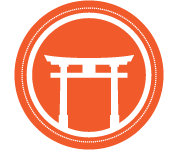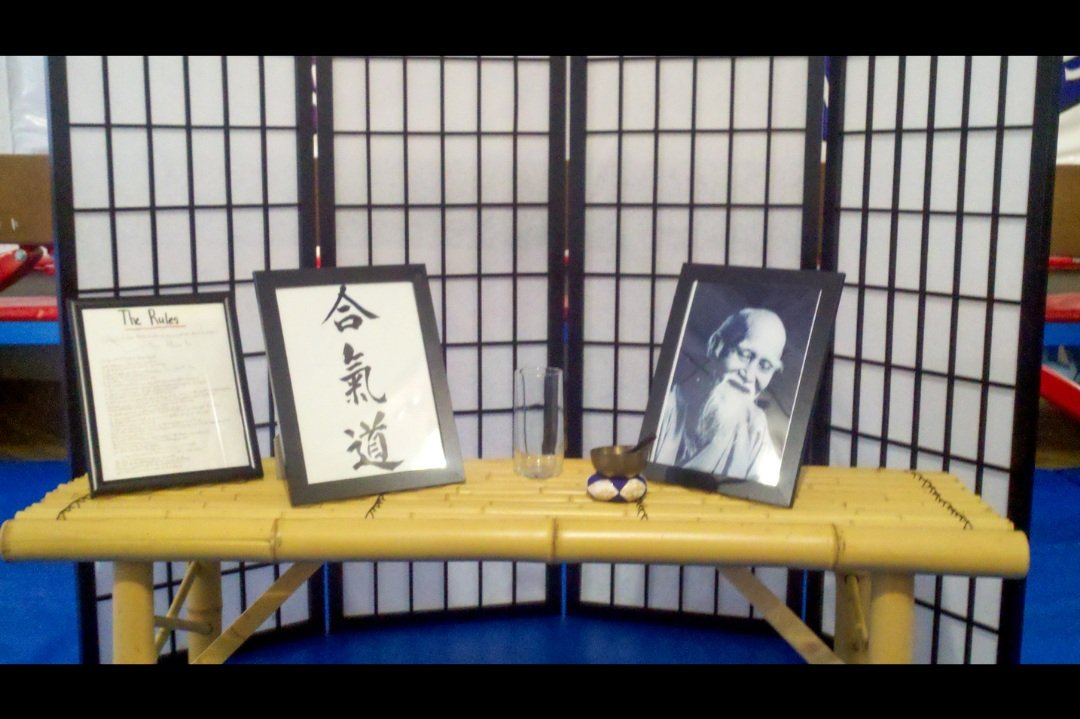Get Centered: The Dojo Shomen
In the Dojo Volume 4 Issue 2
By Josh Paul Sensei, AOSB head instructor
Our shomen was built by Greg Squared Sensei, owner of Great Circles Woodworking.
Every week, I put fresh flowers on the dojo’s shomen. I try to arrange them pleasingly, but usually resign myself to trusting the flowers to make themselves look good. The aesthetics are important. The shomen is the dojo’s focal point – its front wall. When starting class, it is the direction in which students face. At AOSB, it is the first thing people see when entering. It sets a tone and it sets expectations.
In an aikido dojo, the shomen typically includes a photo of O’sensei, a calligraphic scroll that says aikido, and other decorations. Flowers are standard, although I’ve seen stones, books, photos, swords, armor, deer antlers, and even a dried chicken foot.
A shomen is part of every traditional dojo. Even when training outside or in a temporary space, a shomen (also called the kamiza or “god seat”) is present. When AOSB first opened, we practiced at the now lost DUMBO Gymnastics studio and used a collapsible shomen. It was a shoji screen, bamboo bench, and photos. The shomen is one of the features of a traditional dojo that separates it from a gym, school, studio, or really anywhere else.
Our first shomen at DUMBO Gymnastics.
The word dojo originated from Buddhism. It referred to rooms or buildings within a temple or temple complex used for training in different Japanese art forms like tea ceremony, flower arranging, calligraphy, and eventually martial arts like aikido. Sometimes the term dojo was also used to refer to meditation halls.
The shomen is not the only unique part of a dojo. According to Taoist cosmology, each section of the training space is endowed with a special energy. Here is a brief description. The wall opposite the shomen is called the shimoza. Traditionally, the dojo’s entrance would be on this side, and therefore represents the spirit and desire to learn. When facing the shomen, the side to its right is called the joseki. The joseki is the “high” seat. When starting class, students sit in rank order, with higher-ranked students on the joseki side. The joseki side is the space of experience, knowledge, and wisdom. Its opposite, the shimoseki, is the left-hand side of the dojo when facing the shomen. Newer students line up here. The shimoseki is the space of new excitement, energy, and curiosity.
A map of the dojo.
Between the joseki and shimoseki lies the embujo – the space where old and new, experienced and inexperienced, wise and those ready to learn, come together. Here, conflict is created and resolved. The embujo is a charged space. During class, practitioners often unknowingly move away from the center, and gravitate to the edges of the mat.
Aikido is a centering practice. Through training, we try to find and move from our physical center, and to feel centered and balanced. Ideally, aikido training helps generate a sense of serenity, and that serenity is reflected in our training space. Conversely, the serenity of our training space—the quiet, cleanliness, and orderliness—should be reflected in our training. During training, the walls may drip with sweat, there may be gasping breaths, thuds, crashes, and moans. However, when class is over, the dojo reclaims its serenity as if nothing happened. As we should do.
So why are there flowers on the shomen? They add an element of nature and, I hope, natural beauty to the training space (remember, flower arranging is not in my skill set.) And, well, they just look nice.




